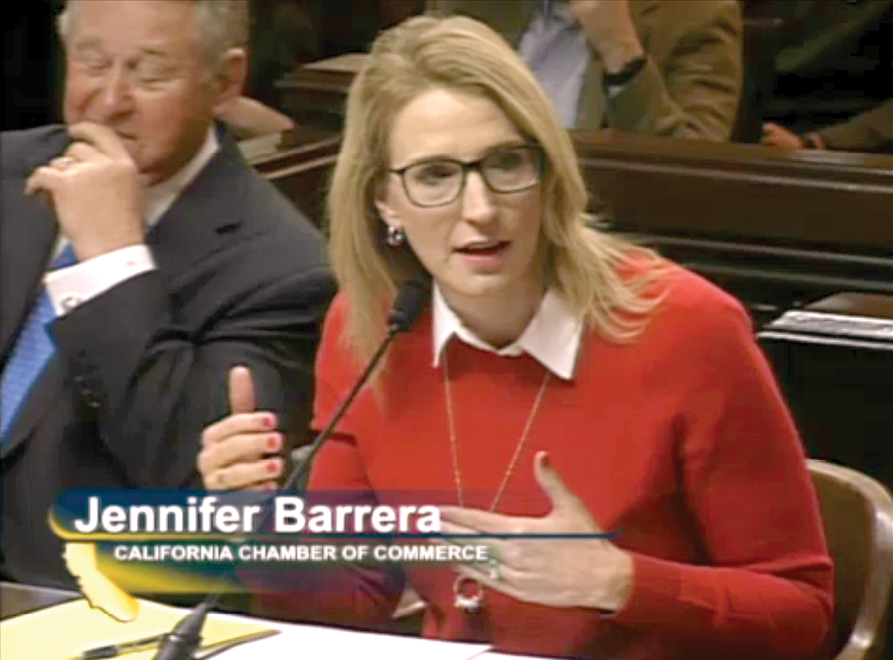
Legislative intervention is needed to provide clarity to employers and prevent loss of opportunities for millions of individuals following last year’s court decision upending the test for determining who is an independent contractor, the California Chamber of Commerce testified this week.
Speaking at an informational hearing of the Assembly Labor and Employment Committee on February 26, CalChamber Executive Vice President Jennifer Barrera outlined the challenges employers face in the sudden change from the independent contractor test in use for nearly 30 years.

In April 2018, the California Supreme Court ruling in Dynamex Operations West v. Superior Court (4 Cal.5th 903) set out a restrictive “ABC” test for determining whether a worker is an independent contractor or an employee.
To be considered an independent contractor, the worker must satisfy all three factors of the ABC Test.
In contrast, the test in use before the Dynamex decision weighed multiple factors in their totality to account for the variety of California industries and professions, as well as the diversity of California’s workers. That 11-factor test was adopted by the court in a 1989 ruling, S.G. Borello & Sons, Inc. v. Dept. of Industrial Relations (48 Cal.3d 341).
Dynamex Test
Under Dynamex, the court presumes that a worker is an employee unless an individual satisfies all three factors of the ABC Test:
A. That the worker is free from the control and direction of the hiring entity in connection with the performance of the work, both under the contract for the performance of the work and in fact;
B. That the worker performs work that is outside the usual course of the hiring entity’s business; and
C. That the worker is customarily engaged in an independently established trade, occupation, or business of the same nature as the work performed.
The “B” prong of the test is the most problematic because many independent contractors work in the same line of business as the hiring entity. As such, most independent contractor relationships cannot survive under the court’s narrow view of the “B” prong.
The court decision in Dynamex places the question of employment classification at the intersection of important competing interests—on the one hand, the state’s interest in protecting workers, and on the other hand, every individual’s personal liberty to contract and be in business for him/herself.
Outdated Wage Orders
Barrera reminded legislators that the Industrial Welfare Commission (IWC) Wage Orders upon which the court based its decision in Dynamex haven’t been updated for more than 14 years—since the IWC was defunded in 2004.
Because there is so much crossover between the Wage Orders and the Labor Code, when requirements are out of synch between the two, complying becomes impossible for the employer, Barrera stated.
She added that professionals who are exempt from the overtime provisions of the Wage Orders still are affected by the Dynamex decision because other Wage Order provisions still apply to those professionals.
Dynamex jeopardizes freedom of choice for individuals and pushes them into a traditional employment model that lacks flexibility.
Although proponents of Dynamex argue that employers who want to provide flexibility to employees can do so under the current state of the law, California’s strict labor laws do not allow for such workplace flexibility.
Retroactivity Unfair
Barrera said legislative intervention also could clarify that the Dynamex decision would apply to cases filed after the ruling and not before.
For businesses to be held retroactively responsible for complying with a standard that didn’t exist at the time of a claim is “extremely and patently unfair,” Barrera stated.
Individual Preferences
As indicated by the U.S. Bureau of Labor Statistics (BLS) Economic Release (June 7, 2018), individuals overwhelmingly prefer their arrangement as independent contractors, and the ABC Test adopted by the court jeopardizes that flexible work arrangement for Californians.
California is estimated to have nearly 2 million residents who work as independent contractors. These numbers are conservative as the 2018 BLS Economic Release did not include the number of individuals who supplement their income with online platforms.
Many Californians are choosing to work full-time as independent contractors and others are using the opportunity to supplement their income. In fact, 79% of independent contractors prefer it over traditional employment, according to the BLS Economic Release.
The top reasons that motivate individuals to pursue independent work include:
• to be their own boss,
• to choose when they work,
• to choose their own projects,
• to choose where they work, and
• to earn extra money.
According to a survey commissioned by Upwork and the Freelancers’ Union, a majority of freelancers who left full-time, traditional employment made more money within a year, are able to work less than 40 hours per week (on average 36 hours), and the majority believe they have the right amount of work.
Independent Contractors Speak
Many independent contractors from across California testified at the informational hearing about why they want to keep their independence and flexibility.
To see excerpts of that testimony, visit twitter.com/calchamber.

